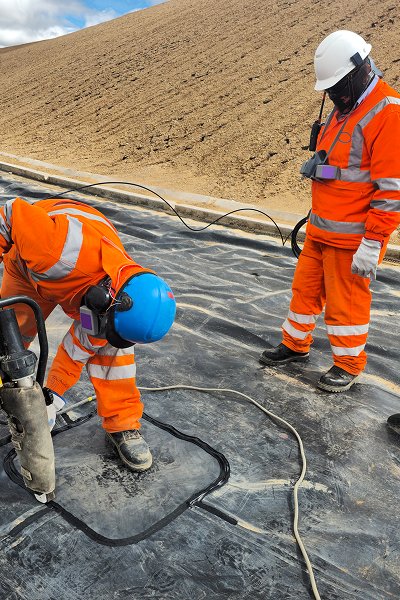What is a geogrid?
Geogrid is a reinforcement material made of high molecular polymer (such as polypropylene, polyester or HDPE), usually with a grid structure. Its main functions include enhancing the tensile strength of soil, dispersing loads, inhibiting base displacement and preventing crack propagation.
Common types:
Uniaxial Geogrid: has high strength in one direction, suitable for retaining walls or reinforced soil slopes.
Biaxial Geogrid: has strength in both horizontal and vertical directions, often used for road foundation reinforcement.
Triaxial Geogrid: a new structure that provides more uniform mechanical properties and is suitable for use in complex road conditions.

Structural issues and challenges in driveway construction
Insufficient foundation bearing capacity
The stability of the lane structure depends largely on the strength and deformation characteristics of the underlying foundation. In areas with weak foundations or backfill soil, if the foundation is not reinforced, its bearing capacity is insufficient and it is easy to sink or shear failure under repeated rolling of heavy vehicles. Such problems are common in the following scenarios:
Peat and silt soil areas;
Construction sites with uneven backfill;
Low-lying areas near water or with high groundwater levels.
Pavement cracking and fracture
Pavement cracks usually appear in the following stages:
Initial shrinkage cracks;
Fatigue cracks during operation;
Temperature cracks caused by thermal expansion and contraction;
Reflection cracks caused by uneven settlement of the base layer.
Rutting and wave deformation
In hot seasons or under heavy traffic conditions, the asphalt surface is prone to "rutting", that is, continuous grooves pressed out by vehicle tires. This structural deformation is mainly caused by the following reasons:
Insufficient shear strength of the base layer;
Asphalt ratio or compaction degree does not meet the standard;
Heavy vehicles run frequently;
Poor drainage leads to increased moisture content and reduced strength of the base layer.
Material loss and base layer damage
Rainwater erosion, groundwater flow and unreasonable design of road drainage system will cause base materials, especially gravel and crushed stone, to be lost with water. This not only weakens the supporting function of the structural layer, but may also cause local voids or collapses in the roadbed. The loss problem is particularly serious in the base layer without any reinforcement material protection.
In sections where heavy vehicles frequently pass, due to the lack of sufficient shear resistance in the structure, the base material can easily move to the sides or bottom during repeated compression, forming a "rolling road" and affecting the overall balance.
The key role of geogrids in lane construction
Enhance the bearing capacity of the foundation; By laying geogrids on the subbase or base, the overall stability of the soil can be significantly improved, weak soil settlement and local shear failure can be suppressed, and the overall bearing capacity of the lane structure can be improved.
Disperse traffic loads; The grid structure of the grid helps to spread the wheel load to a wider area, reduce the concentrated stress at a certain point, slow down the fatigue damage of the base, and increase the service life.
Prevent structural deformation and cracking; Laying geogrids can effectively inhibit the expansion of cracks, especially in areas with large temperature differences or frequent loads, playing a "reinforcement" role and limiting the deformation of asphalt or concrete surface layers.
Save the cost of base materials; Under the same load requirements, adding geogrids can reduce the thickness of graded crushed stone or sand and gravel base, reducing material costs and transportation pressure.
Shorten the construction period and improve construction efficiency; Geogrids are quickly laid and formed in coordination with the compaction layer, which is conducive to improving construction efficiency and accelerating the progress of traffic.

Can geogrids be laid in multiple layers? Is it effective?
Question:
Yes, laying geogrids in multiple layers is very effective in specific projects, especially when dealing with soft foundations or heavily loaded areas.
Notes:
Each layer should be separated by sufficient cushion material (usually 10–30cm);
Avoid directly stacking geogrids, and each layer must be backfilled and compacted to ensure that it works independently;
Structural calculations should be performed to confirm whether multiple layers of reinforcement are really needed to avoid unnecessary material costs.
Can geogrids be used together with geotextiles? What is the effect?
Answer: Yes, and in most cases, it is recommended to use them together.
Usage difference:
Geogrid: Provides structural reinforcement and tensile strength;
Geotextile: Mainly used for isolation, filtration, and prevention of fine particle loss.
Common matching schemes:
First lay geotextile, then geogrid: Suitable for soft soil areas, effectively preventing fine particles from floating up;
First lay grid, then lay cloth: Suitable for special lanes that require surface anti-seepage or filtration functions.
Will the geogrid be damaged when the construction machinery rolls it ?
It is possible, but it can be avoided by the following methods:
Construction equipment must not drive directly on the exposed grid;
A gravel layer with a thickness of not less than 15cm should be backfilled first, and then mechanical rolling should be performed;
If multi-layer compaction is required, a light roller or vibrating tamping tool should be used to compact each layer;
For areas where heavy equipment passes, the protective layer can be appropriately thickened in the design.


